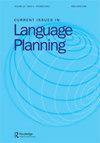高等教育英语教学实践:国际视野
IF 1.8
1区 文学
Q2 EDUCATION & EDUCATIONAL RESEARCH
引用次数: 1
摘要
《高等教育中的英语教学实践:国际视野》为不断发展的电磁干扰研究领域做出了及时而重要的贡献。本书分为宏观分析(国家或地区层面)、中观分析(制度层面)和微观分析(课堂层面)三个部分。全文共21章,每个分析层次有7章。这些章节涵盖了广泛的国际背景,包括欧洲、亚洲、中东、非洲和拉丁美洲的国家。宏观层面的章节侧重于国家层面的EMI政策和政府主导的EMI实施。这些章节涵盖孟加拉国、巴西、中国、丹麦、埃塞俄比亚、尼泊尔和土耳其。章节上下文的多样性提供了系统之间有趣的对比。例如,我们看到EMI与孟加拉国和尼泊尔的(后)殖民统治有关;埃塞俄比亚的百代唱片公司,那里从未被殖民过;将环境保护作为中国的明确政策目标;EMI是丹麦治理改革的意外后果;土耳其的部分EMI;百代在巴西被称为“时尚配饰”。虽然各国在语言背景、历史、文化和治理方面各不相同,但有趣的是,尽管具体表现各不相同,但EMI在不同背景下似乎是不可避免的。中观层面的章节侧重于机构本身。这包括奥地利、哥伦比亚、爱沙尼亚、意大利、本文章由计算机程序翻译,如有差异,请以英文原文为准。
English-Medium Instruction Practices in Higher Education: International Perspectives
English-Medium Instruction Practices in Higher Education: International Perspectives provides a timely and important contribution to the growing field of EMI research. The book is divided into three sections that cover macro-analysis (national or regional level), meso-analysis (institutional level) and micro-analysis (classroom level). There are twenty-one chapters in total, with seven chapters allocated to each level of analysis. The chapters cover a wide range of international contexts, including countries in Europe, Asia, the Middle East, Africa and Latin America. The macro level chapters focus on national-level EMI policies and the government-led implementation of EMI. These chapters cover Bangladesh, Brazil, China, Denmark, Ethiopia, Nepal and Turkey. The diversity in chapter contexts provides interesting contrasts between systems. For example, we see contexts where EMI is associated with (post-)colonial rule in Bangladesh and Nepal; EMI in Ethiopia, which was never colonised; EMI as an explicit policy goal in China; EMI as an unintended consequence of governance reforms in Denmark; partial EMI in Turkey; and EMI as a ‘fashion accessory’ in Brazil. While the countries vary in terms of linguistic backgrounds, history, culture and governance, it is interesting to see how EMI appears to be inevitable across contexts, although the exact manifestation varies. The meso-level chapters focus on the institutions themselves. This includes institutional level EMI in Austria, Colombia, Estonia, Italy,
求助全文
通过发布文献求助,成功后即可免费获取论文全文。
去求助
来源期刊

Current Issues in Language Planning
Multiple-
CiteScore
4.80
自引率
16.70%
发文量
26
期刊介绍:
The journal Current Issues in Language Planning provides major summative and thematic review studies spanning and focusing the disparate language policy and language planning literature related to: 1) polities and language planning and 2) issues in language planning. The journal publishes four issues per year, two on each subject area. The polity issues describe language policy and planning in various countries/regions/areas around the world, while the issues numbers are thematically based. The Current Issues in Language Planning does not normally accept individual studies falling outside this polity and thematic approach. Polity studies and thematic issues" papers in this journal may be self-nominated or invited contributions from acknowledged experts in the field.
 求助内容:
求助内容: 应助结果提醒方式:
应助结果提醒方式:


